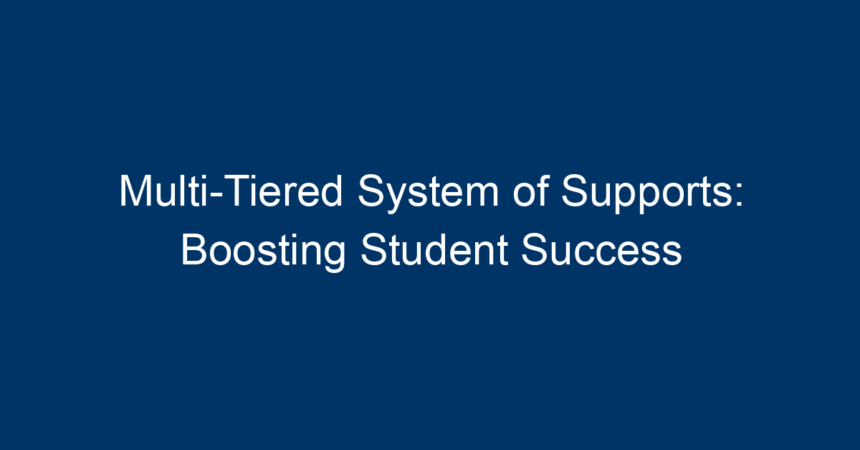In today’s educational landscape, the quest for methods that enhance student success is more urgent than ever. One approach that has gained significant traction is the multi-tiered system of supports (MTSS). This framework not only focuses on the academic needs of students but also addresses their behavioral and social-emotional well-being. By implementing a structured and systematic approach, educators can provide tailored support that leads to improved outcomes for all students. In this article, we will explore the components, benefits, and implementation strategies of a multi-tiered system of supports, making it clear why it is crucial for today’s educational institutions.
What is a Multi-Tiered System of Supports?
A multi-tiered system of supports is an evidence-based framework designed to provide varying levels of interventions based on students’ needs. It is built on the premises of prevention, early intervention, and inclusive education. The MTSS model organizes support into tiers, each providing increasing intensity and individualization:
- Tier 1: Universal supports for all students.
- Tier 2: Targeted interventions for at-risk students.
- Tier 3: Intensive interventions for students with significant needs.
By systematically addressing the diverse needs of students, MTSS helps educators create a responsive and supportive learning environment.
The Importance of a Multi-Tiered System of Supports
1. Addresses Diverse Needs
One of the most compelling aspects of a multi-tiered system of supports is its ability to cater to the diverse needs of students. Every student comes to school with different backgrounds, experiences, and challenges. MTSS allows educators to identify these varied needs and provide tailored interventions that meet students where they are.
2. Focuses on Prevention
Instead of waiting for students to fail before providing assistance, the MTSS model emphasizes prevention. By using early screening techniques to identify students who may struggle, educators can implement interventions at the Tier 1 level. This proactive approach not only reduces the number of students requiring intensive support but also fosters a positive school culture where students feel valued and supported.
3. Encourages Collaboration
Implementing a multi-tiered system of supports also promotes collaboration among educators, specialists, and families. Teachers can work together to share effective practices, monitor student progress, and adjust interventions as needed. This collaborative spirit ensures that all stakeholders are engaged in student success and can collectively celebrate achievements.
4. Data-Driven Decision Making
MTSS relies heavily on data to drive decision-making. Schools can collect and analyze student performance data, behavioral incidents, and attendance records to identify trends and areas that need attention. This data-driven approach not only enhances accountability but also empowers educators to make informed instructional decisions that lead to improved student outcomes.
Components of a Multi-Tiered System of Supports
1. Tier 1: Universal Supports
At Tier 1, the focus is on providing high-quality instruction and proactive classroom management strategies that benefit all students. This includes:
- Differentiated Instruction: Adapting teaching methods to reach a variety of learning styles.
- Positive Behavioral Interventions and Supports (PBIS): Establishing clear behavioral expectations and reinforcing positive behaviors.
- Routine Assessments: Regular formative assessments to gauge student understanding and adjust instruction accordingly.
2. Tier 2: Targeted Interventions
For students needing additional support, Tier 2 offers targeted interventions that supplement Tier 1 strategies. This includes:
- Small Group Instruction: Providing targeted lessons in small groups focusing on specific skills.
- Intervention Programs: Using research-based interventions such as reading or math programs tailored to at-risk students.
- Progress Monitoring: Regularly assessing the effectiveness of interventions and making necessary adjustments.
3. Tier 3: Intensive Supports
Tier 3 is reserved for students who demonstrate significant challenges and require more intensive interventions. This can include:
- One-on-One Instruction: Direct, individualized support from a specialist or teacher.
- Behavioral Support Plans: Creating individualized plans that address specific behavioral issues.
- Collaboration with Outside Resources: Engaging with mental health professionals or outside organizations for comprehensive support.
Implementing Multi-Tiered System of Supports in Schools
1. Establish a Leadership Team
For successful implementation of an MTSS, schools should form a leadership team consisting of administrators, teachers, counselors, and specialists. This team will oversee the planning, execution, and ongoing evaluation of the MTSS framework.
2. Provide Professional Development
Training is essential for educators to effectively implement MTSS. Workshops and ongoing professional development opportunities can equip teachers with the skills they need to utilize data, identify student needs, and apply effective interventions.
3. Foster a Culture of Collaboration
Creating a culture that values collaboration is paramount. Encourage regular team meetings where educators can share insights, discuss student progress, and develop strategies together. This collaborative approach fosters a community dedicated to student success.
4. Monitor Progress and Adapt
Regular assessment of students’ progress is crucial in an MTSS framework. Utilize assessment data to monitor the effectiveness of interventions at all tiers. If a student’s needs are not being met, be prepared to adapt strategies and explore additional support.
Success Stories: Multi-Tiered System of Supports in Action
Many schools have turned to a multi-tiered system of supports and witnessed remarkable improvements in student outcomes. For instance, a school district in Florida implemented MTSS and observed a significant reduction in suspension rates and an increase in reading proficiency levels among at-risk students.
Another case study from a California middle school highlights the importance of collaboration and intervention in the MTSS framework. By engaging teachers in data-sharing practices and implementing targeted instructional strategies, the school improved overall student attendance and academic performance.
Conclusion: Taking Action Towards Student Success
The multi-tiered system of supports is a transformative approach that can significantly enhance student success. By recognizing the diverse needs of learners, fostering collaboration, and focusing on data-driven decision-making, educators can create an inclusive environment where every student thrives.
To fully embrace this framework, schools must:
- Form dedicated teams to lead the MTSS initiative.
- Invest in ongoing professional development for educators.
- Cultivate a collaborative culture across all school levels.
- Monitor and adapt strategies based on data to ensure continuous improvement.
Incorporating a multi-tiered system of supports is not merely an educational trend; it is a pathway to elevating the academic and social-emotional outcomes of all students. Together, let’s pave the way for a future where every learner receives the support they deserve, ensuring that no student is left behind.




